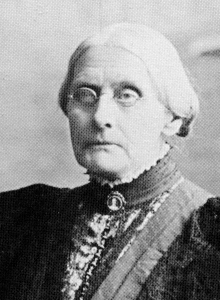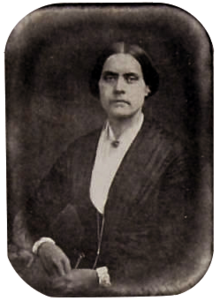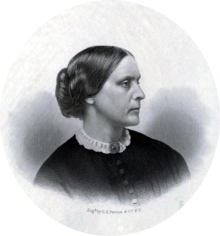SAT写作例子:美国女权运动先驱Susan B. Anthony

Born:Susan Brownell Anthony
February 15, 1820
Adams, Massachusetts
Died:March 13, 1906 (aged 86)
Rochester, New York
Occupation:Suffragist, women's rights advocate
Susan Brownell Anthony (February 15, 1820 – March 13, 1906) was a prominent American civil rights leader who played a pivotal role in the 19th century women's rights movement to introduce women's suffrage into the United States. She was co-founder of the first Women's Temperance Movement with Elizabeth Cady Stanton as President. She also co-founded the women's rights journal, The Revolution. She traveled the United States and Europe, and averaged 75 to 100 speeches per year. She was one of the important advocates in leading the way for women's rights to be acknowledged and instituted in the American government.
Early life

Susan B. Anthony was born to Daniel Anthony (1794–1862) and Lucy Read (1793–1880) and raised in West Grove, Adams, Massachusetts. She was the second oldest of seven children—Guelma Penn (1818–1873), Hannah Lapham (1821–1877), Daniel Read (1824–1904), Mary Stafford (1827–1907), Eliza Tefft (1832–1834), and Jacob Merritt (1834–1900). One brother, publisher Daniel Read Anthony, would become active in the anti-slavery movement in Kansas, while a sister, Mary Stafford Anthony, became a teacher and a woman's rights activist. Anthony remained close to her sisters throughout her life.
Anthony's father Daniel was a cotton manufacturer and abolitionist, a stern but open-minded man who was born into the Quakerreligion. He did not allow toys or amusements into the household, claiming that they would distract the soul from the "inner light." Her mother, Lucy, was a student in Daniel's school; the two fell in love and agreed to marry in 1817, but Lucy was less sure about marrying into the Society of Friends (Quakers). Lucy attended the Rochester women’s rights convention held in August 1848, two weeks after the historic Seneca Falls Convention, and signed the Rochester convention’s Declaration of Sentiments. Lucy and Daniel Anthony enforced self-discipline, principled convictions, and belief in one's own self-worth.
Susan was a precocious child, having learned to read and write at age three. In 1826, when she was six years old, the Anthony family moved from Massachusetts to Battenville, New York. Susan was sent to attend a local district school, where a teacher refused to teach her long division because of her gender. Upon learning of the weak education she was receiving, her father promptly had her placed in a group home school, where he taught Susan himself. Mary Perkins, another teacher there, conveyed a progressive image of womanhood to Anthony, further fostering her growing belief in women's equality.
In 1837, Anthony was sent to Deborah Moulson's Female Seminary, a Quaker boarding school in Philadelphia. She was not happy at Moulson's, but she did not have to stay there long. She was forced to end her formal studies because her family, like many others, was financially ruined during the Panic of 1837. Their losses were so great that they attempted to sell everything in an auction, even their most personal belongings, which were saved at the last minute when Susan's uncle, Joshua Read, stepped up and bid for them in order to restore them to the family.
In 1839, the family moved to Hardscrabble, New York, in the wake of the panic and economic depression that followed. That same year, Anthony left home to teach and pay off her father's debts. She taught first at Eunice Kenyon's Friends' Seminary, and then at the Canajoharie Academy in 1846, where she rose to become headmistress of the Female Department. Anthony's first occupation inspired her to fight for wages equivalent to those of male teachers, since men earned roughly four times more than women for the same duties.
In 1849, at age 29, Anthony quit teaching and moved to the family farm in Rochester, New York. She began to take part in conventions and gatherings related to the temperance movement. In Rochester, she attended the local Unitarian Church and began to distance herself from the Quakers, in part because she had frequently witnessed instances of hypocritical behavior such as the use of alcohol amongst Quaker preachers. As she got older, Anthony continued to move further away from organized religion in general, and she was later chastised by various Christian religious groups for displaying irreligious tendencies. By the 1880s, Anthony had become agnostic.
In her youth, Anthony was very self-conscious of her appearance and speaking abilities. She long resisted public speaking for fear she would not be sufficientlyeloquent. Despite these insecurities, she became a renowned public presence, eventually helping to lead the women's movement.
Early social activism

Susan B. Anthony at age 36In the era before the American Civil War, Anthony took a prominent role in the New York anti-slavery and temperance movements. In 1836, at age 16, Susan collected two boxes of petitions opposing slavery, in response to the gag ruleprohibiting such petitions in the House of Representatives. In 1849, at age 29, she became secretary for the Daughters of Temperance, which gave her a forum to speak out against alcohol abuse, and served as the beginning of Anthony's movement towards the public limelight.
In late 1850, Anthony read a detailed account in the New York Tribune of the first National Women's Rights Convention inWorcester, Massachusetts. In the article, Horace Greeley wrote an especially admiring description of the final speech, one given by Lucy Stone. Stone's words catalyzed Anthony to devote her life to women's rights. In the summer of 1852, Anthony met both Greeley and Stone in Seneca Falls.
In 1851, on a street in Seneca Falls, Anthony was introduced to Elizabeth Cady Stanton by a mutual acquaintance, as well as fellow feminist Amelia Bloomer. Anthony joined with Stanton in organizing the first women's state temperance society in America after being refused admission to a previous convention on account of her sex, in 1851. Stanton remained a close friend and colleague of Anthony's for the remainder of their lives, but Stanton longed for a broader, more radical women's rights platform. Together, the two women traversed the United States giving speeches and attempting to persuade the government that society should treat men and women equally.
Anthony was invited to speak at the third annual National Women's Rights Convention held in Syracuse, New York in September 1852. She and Matilda Joslyn Gage both made their first public speeches for women's rights at the convention. Anthony began to gain notice as a powerful public advocate of women's rights and as a new and stirring voice for change. Anthony participated in every subsequent annual National Women's Rights Convention, and served as convention president in 1858.
In 1856, Anthony further attempted to unify the African-American and women's rights movements when, recruited by abolitionist Abby Kelley Foster, she became an agent for William Lloyd Garrison's American Anti-Slavery Society of New York. Speaking at the Ninth National Women’s Rights Convention on May 12, 1859, Anthony asked "Where, under our Declaration of Independence, does the Saxon man get his power to deprive all women and Negroes of their inalienable rights?"
The Revolution
Susan B. Anthony c. 1855On January 8, 1868, Anthony first published the women's rights weekly journal The Revolution. Printed in New York City, its motto was: "The true republic—men, their rights and nothing more; women, their rights and nothing less." Anthony worked as the publisher and business manager, while Elizabeth Cady Stanton acted as editor. The main thrust of The Revolution was to promote women’s and African-Americans’ right to suffrage, but it also discussed issues of equal pay for equal work, more liberal divorce laws and the church’s position on women’s issues. The journal was backed by independently wealthy George Francis Train, who provided $600 in starting funds. His financial support ceased by May 1869, and the paper began to operate in debt. Anthony insisted on expensive, high-quality printing equipment, and she paid women workers the high wages she thought they deserved. She banned any advertisements for alcohol- and morphine-laden patent medicines; all such medicines were abhorrent to her. However, revenue from non-patent-medicine advertisements was too low to cover costs. In addition, Anthony got President Johnson to subscribe to the weekly journal before the first publication.
In June 1870, Laura Curtis Bullard, a Brooklyn-based writer whose parents became wealthy from selling a popular morphine-containing patent medicine called "Mrs. Winslow's Soothing Syrup", bought the rights to The Revolution for one dollar, with Anthony assuming its $10,000 debt, an amount equal to $184,000 in current value. Anthony used her lecture fees to repay the debt, completing the task in six years. Under Bullard, the journal adopted a literary orientation and accepted patent medicine ads, but it folded in February 1872.


















